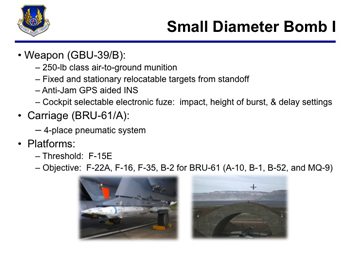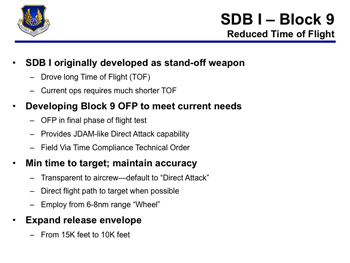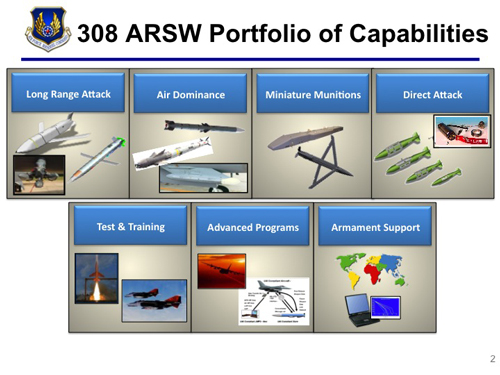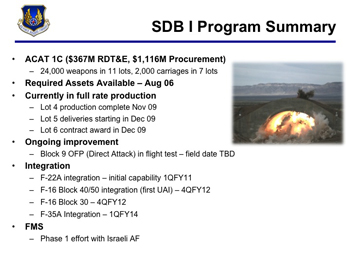The 308th Armament Systems Wing at Eglin Air Force Base:
Weapons Development and the Case of the Small Diameter Bomb I Block 9
In mid-February SLD had a chance to interview Randy Brown, 308th Armament Systems Wing Director, and Lieutenant Colonel Amanda Kato, 681st Armament Systems Squadron Commander, 308th Armament Systems Wing, Air Armament Center, Air Force Materiel Command, Eglin Air Force Base, Florida. This squadron is responsible for the acquisition, production, and sustainment of the Small Diameter Bomb (Increment I) system.
The interview underscored two key elements more generally of interest to those who analyze innovation:
- first, the wing has been infused regularly with officers who have combat experience and the programs clearly have benefited as such;
- secondly, the SDB I Block 9 provided a rapid (18 month) process of change from contract to delivery of a significant capability to the force, which reflects an entirely different concept of operations (CONOPS) than the original SDB I program delivered.
The 308th Wing is a significant player in the evolution of U.S. and allied weapons, and the SDB I Block 9 is a major shift in the CONOPs and capability of the program, which will be introduced into the Afghanistan AOR this Spring.
SLD: Could you explain the role of the 308th Armament Systems Wing?
Randy Brown: For the 308th, we are the Acquisition Wing for all of the munitions that are purchased for the Air Force, and in some cases, with our joint programs, such as AMRAAM and other programs, which we are also purchasing for our sister services and our allies. So we encompass everything from small munitions all the way up through the directed energy systems work. We have a wide range of air-to-air, air-to-ground, and in some cases, some fairly significant advanced technologies that we’re working on. In addition, the 308th Armament Systems Wing develops test and training range instrumentation to support the DoD.
SLD: Does the wartime tempo affect your acquisition efforts as opposed to being a development wing?
Randy Brown: It does. For one thing, we do have a very high deployment rate . The Wing is heavily civilian, so we don’t have a lot of military. But we do have, at any given time, a fairly significant number of our military members deployed, and just the fact that our officers and airmen that are assigned to us are deploying on a fairly regular basis infuses our work. There was one week here not too long ago where we had three deployment taskings come down in one week.
So we’re fairly actively supporting the war just on that front, in addition to responding to requests such as the SDB I, which we’re going to talk about later on, Block 9. Other things we’re doing such, as Massive Ordinance Penetrator (MOP) and other programs where a quick reaction capability is required, we’ll surge, move people into it, get contracts in place and go support the warfighter.
SLD: So presumably, one aspect that helps you in your innovation and supporting the warfighter is the rotation of people on deployment in the AOR and then coming back and working in the Wing.
Randy Brown: That does help because you have first hand experience being over there, either working directly with the folks who are employing the weapon or are supporting the folks on the ground who are the beneficiaries of the weapons that we are developing and deploying. So it does help a lot because it brings it home when you’ve lived there for six months or a year and you come back to the Wing with a different perspective than what you went over there with.
SLD: So it reduces the gap between the development of a weapon and its use.
Randy Brown: We have some of our folks that have deployed two or three times and it does help get rid of that gap between the developer and the eventual user and in our case of guys on the ground, eventual beneficiaries of what we develop.
SLD: Why don’t you discuss the fairly broad portfolio of capabilities that the Wing is involved with and is managing?
Randy Brown: We have the Direct Attack, which has some of the better-known systems, e.g. JDAM. The Laser JDAM was a quick reaction to a request for some additional capabilities that were needed. We have the Miniature Munitions, the SDB is in there, we’ll talk a little bit more about SDB I and then SDB increment II.
In our Air Dominance portfolio, we have the AMRAAM and other air-to-air weapons. The HARM targeting system falls within there also. The Long-Range Attack area includes our air launched cruise missile programs with unique stealthy, precision, conventional, and electronic attack capabilities. JASSM and JASSM-ER are in that part of the portfolio.
In addition we have MALD, which is our Miniature Air-Launched Decoy, which is a decoy system to add to the fog of war.
And then we have MALD-J which is about to enter the engineering and manufacturing development phase and developmental test and evaluation. The MALD-J is not only a decoy, but a jammer, so it brings both elements of deception and electronic attack into the fight.
We also have another area that we don’t talk about too much, but it’s our support to the test ranges and the training capability. So we have things such as the sub-scale targets that we do along with the full-scale targets, the QF-4 and now the QF-16, which is in source selection. We are developing the Common Range Integrated Instrumentation system (CRIIS), a new tri-service test instrumentation system, bringing submeter tracking accuracy, and a secure, efficient, data link to our latest generation of fighter aircraft.
We are also producing P5 for current generation aircraft to support the training community with realistic real-time simulations. P5 operates in a joint US and coalition environment and you’re able to know exactly what occurred on a training mission. You can also play back what you did during that training mission back on the ground and you can analyze it very closely. In fact, our P5 pod was very instrumental in helping solve an accident on an F-16 here not too long ago. We were able to go back – – since the data was down linked, able to pull back that data, replay it for the Accident Investigation Board and show them exactly what had happened.
And those capabilities, because they’re not weapons, they don’t get talked about too much, but they do certainly help train and get the warfighter ready to go to war.
Another area that we work on is weapon effects. We work with the joint community who look at the weapons’ effects, so they’re getting feedback from all the testing, they’re getting feedback from the war, and together with our weapons effects team, try to determine, “Here’s how effective this weapon is against these types of targets.” And it helps the targeteers and the weaponeers say, “Okay, we’re going on a mission today. This is probably the best kind of weapon to use against the targets that we’re going to go against today.” So our folks are heavily involved in that.
Our efforts on munitions effects also helps the Air Force determine the number of additional munitions we need to buy in the future based on how many targets we think we’re going to have to go against and the effectiveness of our munitions against them.
The last area of our portfolio is our Advanced Programs. We have things in there such as the Advanced Tactical Laser Project, which was a laser evaluation that fired for the first time a high powered laser from an airborne platform engaging a ground target. That effort is now complete. We also have the Active Denial System, which is a system that the Army is getting ready to take forward into the war. In fact, it’s at Quantico now. It’s getting ready to go over to the West Coast here fairly shortly to get a little bit more testing and then get boxed up and sent over to the AOR. So it’s going to go over there and the folks are going to use it to see if it will help them with some of the work they’re doing with either trying to disperse crowds or do some control.
So our Advanced Technologies folks really are kind of the gateway into the Wing. They are very heavily involved with what is going on in the labs and with our planning organization, XR, and they’re our connection there. So we also use them sometimes to shape fast track technologies, i.e., technologies that look like the’re promising and has some warfighter “game changing” capabilities, and so we’ll try to fast-track some stuff through them and get it out to the warfighter quickly.
SLD: Just a couple of reactions: first, even though you’re an Armament Systems Wing, you’re very much part of the evolution of joint war fighting and support for the joint warfighter; and secondly, you appear to be at the heart of what could be referred to as the ground-air revolution whereby the air element is part of the solution set for ground operations, is this correct?
Randy Brown: Yes, we are. And in fact, we’re getting even more involved now with an area we didn’t think too much about, but has come up, especially with Afghanistan. We’ve stood up a medium caliber ammo office because now, with all of the striking that’s going on, we are finding we need to do some more work and some more development in the 20 millimeter ammo area, so we are working on that. So people sometimes think okay, you’re just doing air-to-air weapons or air-to-ground weapons. No, we’re – – as you said — working across the spectrum of things. Whatever is needed to support the warfighter, especially the folks on the ground right now, including literally bullets, all the way through microwaves, becomes our purview.

SLD: Let’s finally focus on one of the programs that allow folks to understand your whole process of innovation and support to changes in the AOR, namely the Small Diameter Bomb Program area. People are aware, I think, that there’s a competition for what’s going to be called SDB II, and that you helped stand up SDB I. What many people are not aware of is that you have almost a program, namely SDB I Block 9 that already introduces significant change into the original SDB program. Could you talk a little bit about how that requirement came to be and the differences between the classic SDB I and what Block 9 is going to look like and how that whole challenging process of innovation over the last few years has been put together?
Randy Brown: This is where I’m going to blame Amanda for success, so she’s going to step over here and talk to you.
Lieutenant Colonel Kato: Small Diameter Bomb I was developed as a long-range stand-off weapon for a different fight than the fight it’s being used in right now, different kind of CONOPs, where a stand-off would be particularly useful, namely against fixed targets. The genesis of the program was originally a Small Diameter Bomb program with two increments and it was all one big program where you would get the first capability out there first, the easier part as it were, against the fixed targets and then the part that’s challenging to everyone, is the how do you do the moving targets. But because of procurement issues the program was split apart between SDB I and SDB II. So now we’re two fully separate program offices and we work for the same boss.
It was developed as a long-range stand-off weapon and was originally delivered to the AOR in October of 2006, first used in combat in November of 2006 and had a total of 49 combat releases through July of 2007. All in all, there’s a lot of success with that. It is currently fully integrated on F-15E, and we are working on F-16s, Block 30s/40s//50s, F-22, as well as the F-35A.
SLD So the core program provided capability against fixed targets, but changing demands required a modification of the capability?
Lt. Col. Kato: They stopped using SDB I in July ’07 in the AOR for several reasons. First of all, some of the operations weren’t in urban environments where low collateral damage mattered. In fact, some of the missions needed a bigger boom, so 500 and 2,000-lb JDAMs were better weapons of choice for the targets that they were prosecuting. Secondly, because it’s designed as a stand-off weapon, it takes a long time to get there because the way it was developed is that it was intended to maximize its glide slope so that it could get the maximum range.
And there was the question of time to target. The pilot says, “Okay, released.” And the guy on the ground says, “Okay, how long?” And he says, “Four and a half minutes.” And the guy says, “What?” In a CAS fight, that’s not good, that’s not the best option if you’re the guy on the ground having to clear air space while troops are likely in contact with the enemy for that long.

Lt. Col. Kato: Yes, you can see why that was not particularly optimum. And really, that’s the genesis of the Block 9 software. So for Block 9, it’s totally a software change. It requires no physical changes to the weapon at all.
So we started that development effort about a year and a half ago and what it’s designed to do is to minimize the time of flight and give you that JDAM-like kind of capability in terms of getting there faster, again still with the accuracy of the current system and low collateral damage. Also, it expands the release envelope down to 10,000 feet. So those are the two main things that go into Block 9.
We completed all of our flight testing in January 2010.
Sldinfo: You said it was a software development that can always be challenging: how long from gestation to delivery was this process? It probably was a pretty challenging process to modify a weapon design for quite a different CONOPs to reshape it for the CONOPs for this current AOR?
Lt. Col. Kato: It’s taken us about 18 months We hoped it would go faster, but as you said, doing some of the additional algorithm changes to allow the weapon to get to the target faster, yet still maintain its accuracy, proved to be very challenging, to be honest.
SLD: Now when might this potentially be introduced into the AOR?
Lt. Col. Kato: We would love to see it as soon as March. When the final approval to field the software comes through, it will then be processed out on PCMCIA cards and they ship them out to the various field locations, and they can load it right into the weapons and bomb racks and it’s ready to go.
SLD: So that the stockpile of weapons already available in theatre just need a modification with the card that you’re putting into the bomb?
Lt. Col. Kato: You hook it up to the test set and it loads the software. It’s just the software load; there are no physical changes to the weapon or to the bomb rack.
SLD: So to summarize: in 18 months from contract to delivery you were able to shape a new software package for the current stock of SDB weapons and shape an entirely new CONOPs?
Lt. Col. Kato: Yes: the old weapon was designed for stand-off strikes against fixed targets; the new weapon will be able to support CAS missions even in urban environments and deliver a much more rapid rate of delivery.
———-
*** Posted on March 16th, 2010



